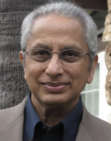RRDProjectFINAL.mp3
Smritee [00:00:05] I grew up in a Nepali household with Hindu parents, and since I can remember Hinduism has played a huge role in my life. We have a prayer room filled deities, when I was young, my mom would read stories about Hindu gods and goddesses, and we celebrated Hindu holidays, at least as well as we could in the United States. I grew up Hindu, but I knew that I didn't know everything, if for no other reason than how expansive and diverse Hinduism is. In my second year of college, I became more interested in how religion and ecology intersect, especially within Hinduism. In particular, I became interested in how Ecofeminism and Hinduism intersect in South Asia. I was first introduced to Ecofeminism while reading excerpts from books like Braiding Sweetgrass and the Power and Promise of Ecological Feminism in class. Our discussions centered women, believing that women shared a special connection with nature. Early Ecofeminists defined their practice as "women caring for the world." But the movement has evolved.
Mary Mellor [00:01:05] "It seems to me there's been a resurgence of interest in Ecofeminism, because I've been around in it for almost as long as it's been going."
Smritee [00:01:14] That's Mary Mellor, author of the book Feminism and Ecology. She defines Ecofeminism as "a movement that sees a connection between the exploitation and degradation of the natural world and the subordination and oppression of women." I found Mellor's comments to be a helpful starting point, but we'll come back to this later.
Mary Mellor [00:01:32] "The important point of analysis from my perspective here, is to allow us to analyze the structures of power that intercede between us as humans and the natural world. So my Ecofeminism is about looking at the social structures that undermine sustainability and social justice."
Smritee [00:01:51] Ecofeminist pioneer Vandana Shiva also looks at power and the ways Ecofeminism can intersect with -- and teach us how to address -- social justice issues like environmental racism, white supremacy, women's rights and climate change.
Vandana Shiva [00:02:05] "How does Ecofeminism decolonize this violent process -- of a war against life itself and the war against women and the war against the future? By removing the false assumptions of superiority and separation. Those are the two key issues: the false assumptions that we are separate from nature and powerful men are masters of nature. The false assumption that powerful men are in charge of our future and the false assumption that some races, some religions, are superior.
Smritee [00:02:39] But these definitions are adapted in different ways throughout the world, and no one single definition captures what Ecofeminism is in all local contexts. I wanted to learn more about the relationship between contemporary understandings of Ecofeminism and Hinduism.
Smritee [00:03:00] Have you found that devotees of Hindu goddesses believe that women are intrinsically closer to nature and the Earth?
Dr. Shimkhada [00:03:06] Oh yes, definitely. They are very closer to Earth.
Smritee [00:03:11] That's Dr. Deepak Shimkhada, an adjunct professor at Chaffey College.
Dr. Shimkhada [00:03:16] I'm really fond of Hindu goddesses because I grew up within the environment of Hindu goddesses in Nepal because my father was a goddess worshiper.
Smritee [00:03:32] Remember this quote from earlier?
Mary Mellor [00:03:35] "It seems to me there's been a resurgence of interest in Ecofeminism."
Smritee [00:03:43] For me, it raised the question, How long has Ecofeminism been around? Or more specifically, how long have the ideas of Ecofeminism been around?
Dr. Shimkhada [00:03:52] Ecofeminism as you know, you know, I don't have to tell you, is a modern concept in the West, right? So even though this is a new concept in the West, for us, I think if you go back to ancient times, I think, you know, the goddess worship was part of life. There was no need for invoking the idea of Ecofeminism as a subject, as a genre. It was there. It was part of life. Women lived it and then tried to live in harmony with nature. The nature itself is called Prakriti. Prakriti is female, so nature, Earth, everything is interrelated. And of course, females are a part of the Earth.
Dr. Drew [00:04:35] Where my perspective differs and where I think a lot of contemporary Ecofeminists take their point of difference now is that I'm in no way, shape or form saying that women have an innate relationship with nature or the environment that is innately better than, or perhaps more intrinsic to their being than men.
Smritee [00:04:57] That's Dr. Georgina Drew, a senior lecturer at the University of Adelaide. She does believe that women have different relationships to the environment than men do, but not because it's their nature. It's because, she says, they're different class, castes, and their roles within the household and society create different modes of being in a landscape.
Dr. Drew [00:05:16] Feminism is a movement towards equality, promoting the equality of people from all different sorts of genders and orientations. Increasingly, this is an intersectional stance. So if we take that stance on feminism and apply it to the environment, then we must talk as well about how gendered bodies in all their forms and manifestations and diversities have diverse experiences of the environment relative to the practices and the divisions of labor that they're given.
Smritee [00:05:49] Dr. Drew's call for more intersectionality within Ecofeminism would also benefit from including the intersection of Hinduism to further understand women's relationship with the environment in South Asia. To learn more about this, I asked Dr. Shimkhada about how Hindu concepts of femininity affect Ecofeminism in South Asia. Shakti turned out to be an important part of this discussion. What is Shakti and how does it relate to the environment and Ecofeminism?
Dr. Shimkhada [00:06:18] Shakti is a Sanskrit word, it basically means energy. You know, anything that has a power, anything that has energy. One important thing we have to understand is that Shakti, any form of Shakti according to Hindu understanding, is feminine in gender. In Hinduism, that Shakti is seen as a female. And it is treated as a goddess. And of course, without Shakti, God has no power. To be powerful, God should have his left half and his right half. But for example, Shiva has half of his body is Parvati, his female half, and then the right half is a male half and two together makes it a whole. What makes whole is the Shakti, his female energy. The moment you minus Shakti from Shiva and then Shiva becomes Shava. The word Shava is corpse, is a dead body, right? So he becomes dysfunctional, no energy, no function at all. So and that's why, you know, Shakti is a very important part of a Hindu concept, in Hindu religion.
Smritee [00:07:40] Dr. Shimkhada explained how Shakti and Hindu concepts of femininity are played out and how they affect women's roles in South Asia.
Dr. Shimkhada [00:07:48] So obviously, women are whether or not they are treated like goddess, but at least in theory, in principle, they are like goddesses. I think in Nepal, the rice planting ceremony, this is the season where they plant rice in the rice fields and well, the men, they go there and they prepare the field. And it is the job of the women to plant the rice. They have the power to to germinate. Right. Perhaps if the male plants it, it will not grow. I suppose it may grow. I don't know. But you know, in theory, because they are fertility goddesses. And then if they plant it, you will have a successful harvest, a very healthy harvest. That is why men do not go in the field. All the women go on the field and start planting the rice. So obviously they are very, very close to Earth. And then, of course, you have to plow the field and then plowing the field is giving pain to Mother Earth. So you know what they do is they have a rice plowing a ceremony and then they pray. Please forgive us because we have to eat. We have to plant rice so bear the pain for us so that we may live from your bounty. So this is, you know, a give and take kind of thing, a bit between human beings who have to rely on Earth. And then of course, since Earth is a mother goddess, so they treat as an actual living entity and then they beg forgiveness before doing this.
Smritee [00:09:30] Dr. Drew attributed these roles that women are in more to secular aspects of their lives and the environment,
Dr. Drew [00:09:36] Class and caste in South Asia are also tied to those diverse and disparate divisions of labor that they're given. And then therefore people from various genders who are forced into or are given opportunities to work in an environment with the environment in certain ways that we can understand from them how they see environmental concerns and environmental opportunities. And then we can then use those insights to help work with them and see the value of the concerns that they're raising.
Smritee [00:10:12] Dr. Drew found evidence to support her theory doing fieldwork in the Himalayas.
Dr. Drew [00:10:18] I was working with women and Garwhali women, many of whom had low levels of education but high levels of experience and everyday practice alongside the Ganga. And also growing awareness of the ecological changes that were taking place. And so I really looked at women's roles in the movement to stop hydroelectric dams again on this free flowing stretch of the Ganga.
Dr. Drew [00:10:41] So one of the things that I was really trying to point out is that in the region that I've been working in or that I had been working in at the time, there was a huge outmigration of young, able-bodied male presenting persons, a growing trend that is now called the feminization of agriculture. So there's a lot of women in this region who have kind of been left to take care of the landscape because a lot of male presenting bodies have had to leave because they're the ones that are seen as best suited to go work in the cities of India or work in the cities of the Gulf states or in Malaysia or somewhere else to send back money to support the households. So women are left behind. And that means that women have a lot of time spent managing the farms, managing the landscapes adjacent to the farms, seeing floods, seeing landslides, seeing the destruction of new roads being built, seeing the destruction of new dams being built, and that these things, combined with past histories, are part of the things that motivate women to feel like they have to take a stance because there is no other alternative.
Smritee [00:11:53] It was fascinating to hear how differently Dr. Shimkhada And Dr. Drew understood similar situations. Dr. Drew saw that women were the ones working and taking care of the land and attributed this to being left behind and experiencing the environmental degradation of the land and its surroundings. And as a result, she calls for a more intersectional Ecofeminism. Dr. Shimkhada sees women working the land as a continuation of rituals that center them as fertility goddesses and planters, and argues that Ecofeminism is not new in South Asia but has always been important for Hindus. It was profound to hear how the cultural context shifted the lens of understanding so much between our two guests. I came away with the feeling that their differing opinions represent two distinct understandings of intersectionality. And personally, the interviews reinforced my belief that understanding the origins and history of cultural and religious practices is an important part of intersectionality that cannot be lost. But these differences do not mean that the two perspectives can't be combined. Adding the religious aspect to a call for greater intersectionality in Ecofeminism allows for further understanding of how Ecofeminism plays out in Hinduism in South Asia and including more native voices in the conversation helps us think about the crucial context.
Smritee [00:13:17] This audio project was produced for the Religion, Race and Democracy Lab at the University of Virginia with help from the lab's senior producer, Emily Gadek and the lab's editor, Kelly Hardcastle Jones. Special thanks to Camaran Gaillard for helping me with this project, to Dr. Aidan-Seale Feldman for connecting me with Dr. Drew, and to my family for educating me and implementing Hinduism throughout my life. Music for this project comes from Blue Dot Sessions. You can find more documentary research on religion, race and democracy at religionlab.virginia.edu






